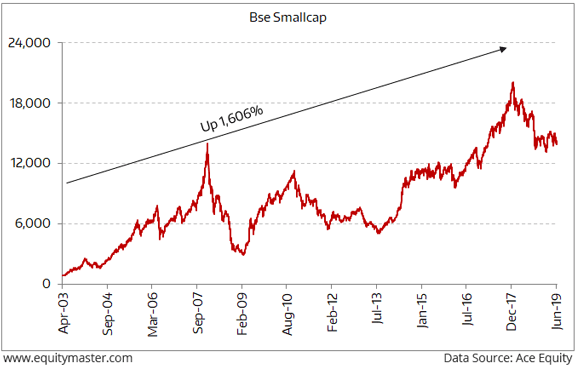My 3 Best Small-cap Stocks to Get Rich in this Market Rebound
As I write this, the World Bank has taken a grim view of India's economic affairs.
It has slashed India's GDP projection to 6%, a downgrade of 1.5% from its previous forecast.
It cites both cyclical and structural factors. The key culprit stands out to be the liquidity crisis...and the debt saddled corporate balance sheets.
Now before you take these gloom doom sayings very seriously, you should revisit history.
Here's an excerpt from Working Paper by Indian Council for Research on International Economic Relations in 2009.
The Indian economy was on a cyclical slowdown after a five-year record boom and there was every hope that the economy will go for another strong growth phase after this brief slowdown. The global crisis has changed that outlook and instead will deepen and prolong Indian economy's slowdown. It has dealt a severe blow to investment sentiments and consumer confidence in the economy. The policy response so far has been prompt in the form of monetary easing and fiscal expansion but the impact may not be much in the near term. A major worry is the severe weakening of India's fiscal position and balance of payments during this crisis period. The basic question is how long it will take to revive the investment and consumer demand which are falling precipitously.
It would be, therefore, realistic to say that the GDP growth rate for 2009-10 would be in the range of 4.8 to 5.5 per cent.
By the way, did I mention that India's GDP in 2009-10 grew at 8.59% in 2009-10 and at 8.9% in 2010-11.
Now, consider this from the Harvard Business Review in May 1997:
'India has a long way to go to overcome a host of problems such as food production that loses 30% each year to spoilage; an energy distribution system that loses 25% to leakage during delivery; crumbling roads, ports, and airports; and a primitive telecommunications sector. India is falling further behind its Asian rivals in economic reforms, a problem that may jeopardize its ability to attract foreign capital in the future.'
That was one of the biggest problems with much of analysis of the Indian economy and so called economists.
They just didn't understand India's potential.
Most still don't.
They can't fathom the growth rates of a country where the population has grown from one billion people, to 1.3 billion people in just 22 years.
They can't fathom how a country like India can grow its national wealth from US$462 billion in GDP to US$2.6 trillion in 17 years.
And they can't fathom how GDP per capita has more than quadrupled since 2000.
To make a comparison, US GDP per capita has only increased 63%, while UK GDP per capita has only increased 42%.
Now, while many have doubted India, since 2003, one particular group of stocks has gained over 1,600%.
And I expect more to come.
Look at this chart of the BSE Smallcap index.
What stands out the most?
I mean, aside from the fact that the index has gained nearly 17 fold since 2003.
Over the last 16 years, the index has seen several massive fluctuations.
And despite these occasional large fluctuations - the overall trend of the index has been UP.
It has gained over 1,600%. And a compounded annual return of 19%.
Those who were wise enough to bet on quality smallcaps at the time of crashes, when fear ruled smallcaps, have compounded their money at a multiple of that rate.
2019 is one such phase of phase of fear.
To be sure, some of the economic concerns are real. And the companies with bad managements and balance sheets will only destroy more wealth. But if you could choose your smallcap bets wisely, rebound riches could be yours.
Keeping this in mind, I've shortlisted three stocks that I believe are not just safe amid a volatile economic environment, but could set one for handsome gains in the long term.
Stock #1: This company is a supplier to three of the fastest growing industries (technology, health, and finance). It has grown sales at a compound annual growth rate of 16% in the last four years. And its net profit margins have averaged at 12% over last five years.
What's more...It pays out around 25% of its profits as dividends...and the net cash and current investments comprise over 20% of the market cap.
The financials are a lot more stable than many large cap companies.
Stock #2: This company operates in an economic heaven, and it could be one of the biggest beneficiaries of the market rebound.
The company commands a market share of more than 40%. And there is almost certain that you would be using its services - probably without even knowing it. Yes, this single business has a quite a few attributes that any winning business might ever possess. These include a high entry barrier caused by regulations, and strong client stickiness.
These include a high entry barrier caused by regulations, and strong client stickiness.
And did I mention the zero debt and a huge operating leverage? While expenses remain the same, any increase in revenue directly flows to profits.
Now this company does not need much capex to grow its revenues. So, what does it do with all the profits it earns?
Well, it distributes a significant chunk as dividends...that leads to steady income for its investors.
I have been thinking hard about how this business could be disrupted...and have realised the business itself is an ultimate disruptor.
Stock #3: This company has grown sales by more than 26% over the past five years, and grown net profit by 53%. Plus, (and this is the best bit) it has done so while increasing its operating and net profit margins. That's a standout achievement in my view. Furthermore, the company has very little debt on the books. That's the kind of stock one would like to bet on in current times.
| ||||||||||||||||||||||||||||||||||||||||||||||||||||











No comments:
Post a Comment